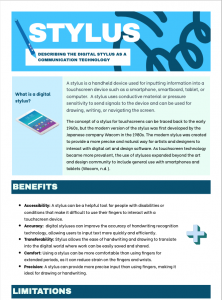STYLUS – Describing Communication Technologies < click here for PDF version



Reflection
I began the process of deciding which communication technology to explore for this final project while exploring the module on multimodality. I took a look around my home and thought about what sort of digital technologies I own that combine multiple literacies into one medium. After some searching I stumbled across the stylus for my partner’s laptop. Although it is not a tool that I use myself, I was immediately struck by what an interesting case study in communication technology it might be.
It was not immediately apparent to me that the digital stylus in my home is there thanks to an evolution of the same tool that folks used thousands of years ago. I have now come to realize that the stylus is perhaps the most ancient writing tool, apart from our hands themselves. It is interesting to consider how the stylus that was used to engrave clay, or wax, while conceptually the same, is now a digital technology that remains a useful tool for human expression even in the year 2023.
This exploration of the stylus has encouraged me to think about incorporating it into my own personal and professional practice, after learning about the benefits of how it can be beneficial for handwriting development (something I have learned I need to work on after completing the manual scripts task), improve performance and engagement and hopefully it will be effective in inspiring some creativity within myself and my students. While styluses are not something that are currently in the budget to provide to students in my classroom, I realized that there are already styluses in the classroom that are attached to the smartboard. Allowing students to get engaged in a tactile manner with the lesson on the smartboard may prove to be effective in gaining that motivation and engagement to promote deeper learning in students.
References
Grosvenor, A. (2021, February 25). Stylus Pros and Cons: Should You Use One? The Digital Artist’s Handbook. https://digitalartiste.com/stylus-pros-and-cons-should-you-use-one/
Kress, G., & van Leeuwen, T. (2006). Reading images: The grammar of visual design. Routledge.
Lamb, R., & McCormick, J. (Hosts). (2020, May 26). From the vault: Invention of the book, part 1Links to an external site. [Audio podcast episode]. In Stuff to blow your mind. iHeart Radio.
Lee, K., & Lim, S. (2019). Digital Stylus-Based Writing Instruction for English Language Learners. TESOL Journal, 10(3), e00124.
O’Halloran, K. L. (2011). Multimodal analysis and digital technology. In The Routledge handbook of multimodal analysis (pp. 312-324). Routledge.
Ouyang, M., & Chang, C. (2019). The Effects of Digital Stylus on Writing Performance and Motivation for College Students with and without Disabilities. Journal of Educational Computing Research, 57(2), 327-344.
Pahl, K. (2018). Stylus writing in digital environments: Multimodal writing and the digital pen. Routledge.
Powell, B. B. (2014). Writing: Theory and history of the technology of civilization. John Wiley & Sons.
Roueché, C. (2013). Writing tablets from Roman Britain. Cambridge University Press.
Schiffer, A. A., Reimer, C. B., & Anderson, M. (2018). Effects of a digital stylus on handwriting development. Journal of Occupational Therapy, Schools, & Early Intervention, 11(4), 374-385.
Ye, L., Wang, J., & Du, J. (2017). Exploring the effect of digital stylus on Chinese handwriting. International Journal of Emerging Technologies in Learning, 12(9), 155-166.
Wacom. (n.d.). The History of the Stylus. Retrieved April 7, 2023, from https://www.wacom.com/en-us/discover/history-of-the-stylus
West, R. E., & Graham, C. R. (2018). Using digital stylus technology to improve student writing: A systematic review. Computers & Education, 126, 296-313.
Wobbrock, J. O., Morris, M. R., & Wilson, A. D. (2009). User-defined gestures for surface computing. In Proceedings of the 27th international conference on Human factors in computing systems (pp. 1083-1092).
